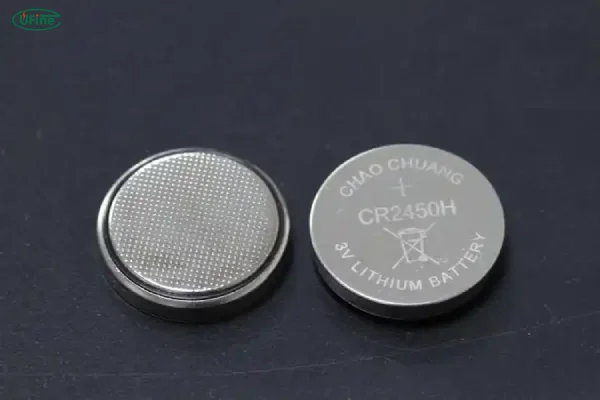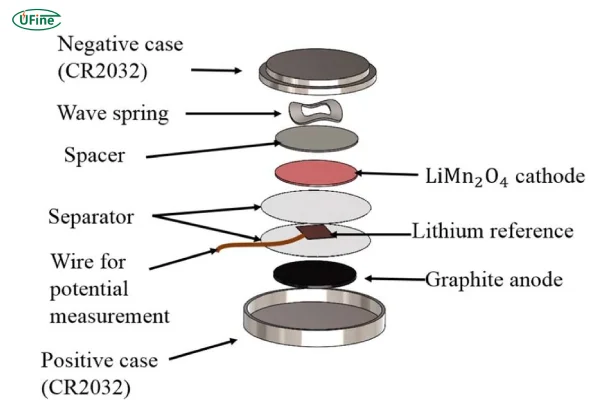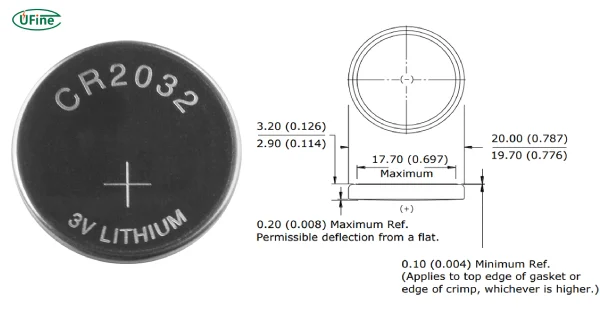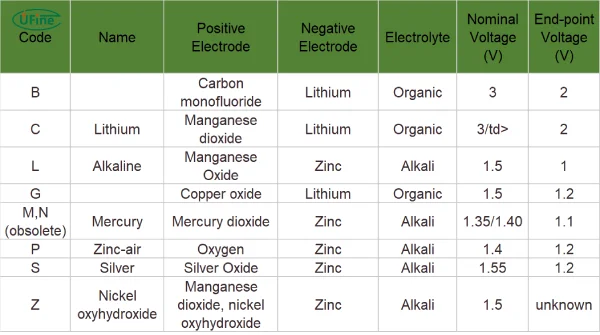
Part 1. Learn button battery?
A button battery, also known as a coin cell, is a small, round, flat battery commonly used to power compact electronic devices. They are renowned for their lightweight design, long shelf life, and reliable performance. These batteries are often found in devices like wristwatches, hearing aids, calculators, remote controls, toys, and medical instruments.
Internal Components
The internal structure of a button battery is ingeniously designed to maximize efficiency and energy storage in a small form factor. Let’s delve into its key components:
-
Cathode (+):
The positive terminal is usually made from materials like manganese dioxide (for lithium batteries), silver oxide, or zinc-air, depending on the battery type. This material determines the battery’s chemistry and performance. -
Anode (-):
The negative terminal, often made of zinc or lithium, reacts with the cathode during the discharge process, generating electricity. -
Electrolyte:
The electrolyte serves as the medium for ion exchange between the anode and cathode. It can be liquid, solid, or gel-based, depending on the specific battery design. -
Separator:
A thin, insulating layer separates the anode and cathode to prevent short-circuiting while allowing the free flow of ions necessary for electricity generation. -
Outer Casing:
Made of stainless steel, the casing protects the internal components while acting as one of the terminals (usually the negative pole).
Learn About the Cathode and Anode of the Battery
Working Principle
The button battery works through a simple yet effective electrochemical reaction. When connected to a device, the chemical reaction between the cathode and anode generates a flow of electrons. These electrons travel through the external circuit, powering the connected device. The type of electrolyte and electrode materials used directly impacts the battery’s efficiency, capacity, and voltage output.
Key Characteristics of Button Batteries
-
Compact Size
-
Lightweight
-
Consistent Voltage Output
-
Long Shelf Life
-
Environment-Specific Designs
Part 2. Naming rules of button batteries
The naming convention for button batteries isn’t arbitrary; it’s a standardized system that provides key information about the battery’s specifications, including its chemical composition, size, and physical shape.
For example, consider the CR2032 battery:
- C: Indicates the chemistry. “C” stands for lithium manganese dioxide, a common chemistry for high-performance button batteries.
- R: Denotes the round (coin-like) shape.
- 20: The diameter of the battery, measured in millimeters. In this case, 20 mm.
- 32: The thickness of the battery, expressed in tenths of a millimeter. Here, 3.2 mm.
This systematic naming helps users identify the correct battery for their device without confusion. Similarly, silver oxide batteries (e.g., SR44) and alkaline button batteries (e.g., LR44) follow similar conventions, with the first letter denoting the chemistry type.
Examples of Common Button Batteries
| Code | Diameter (mm) | Thickness (mm) | Chemistry | Applications |
|---|---|---|---|---|
| CR2032 | 20 | 3.2 | Lithium | Watches, fitness trackers, key fobs |
| SR626SW | 6.8 | 2.6 | Silver Oxide | Precision instruments, medical devices |
| LR44 | 11.6 | 5.4 | Alkaline | Toys, remote controls, small flashlights |
| PR44 | 11.6 | 5.4 | Zinc-Air | Hearing aids |
CR Battery Sizes: A Complete Guide
Part 3. Button battery types
Button batteries come in various chemical types, each tailored for specific applications. The chemistry determines the battery’s voltage, capacity, shelf life, and suitability for specific devices. Below is an overview of the most common types:
1. Lithium Button Batteries
These are some of the most widely used button batteries. They are known for their high energy density, long shelf life, and ability to operate in extreme temperatures.
- Voltage: Typically 3V.
- Applications: Watches, key fobs, calculators, and fitness trackers.
- Advantages: Long-lasting, lightweight, and stable performance.
2. Silver Oxide Button Batteries
Silver oxide batteries are preferred for high-drain devices due to their stable voltage output.
- Voltage: Typically 1.55V.
- Applications: Medical devices, cameras, and precision instruments.
- Advantages: High capacity and consistent performance over time.
3. Alkaline Button Batteries
Alkaline batteries are commonly used in devices requiring moderate power consumption.
- Voltage: Usually 1.5V.
- Applications: Toys, small flashlights, and basic remote controls.
- Advantages: Affordable and widely available.
4. Zinc-Air Button Batteries
Zinc-air batteries are specifically designed for hearing aids and other auditory devices.
- Voltage: Typically 1.4V.
- Applications: Hearing aids, pagers.
- Advantages: Excellent energy-to-weight ratio and environmentally friendly.
Comparison of Button Battery Types
Part 4. Button battery size chart
The size of a button battery is an essential factor in its compatibility with devices. The naming rules simplify the process of selecting the right size. Here’s a breakdown of the naming system and a size chart for quick reference.
Naming Rules
As discussed earlier, the naming convention is standardized and includes:
- Prefix Letters: Indicate the chemistry (e.g., CR for lithium, SR for silver oxide, LR for alkaline).
- First Two Numbers: Represent the diameter in millimeters.
- Last Two Numbers: Indicate the thickness in tenths of a millimeter.
Common Button Battery Sizes
| Battery Code | Diameter (mm) | Thickness (mm) | Chemistry |
|---|---|---|---|
| CR2032 | 20 | 3.2 | Lithium |
| CR2025 | 20 | 2.5 | Lithium |
| SR626SW | 6.8 | 2.6 | Silver Oxide |
| LR44 | 11.6 | 5.4 | Alkaline |
| PR44 | 11.6 | 5.4 | Zinc-Air |
Part 5. Voltage
Button batteries come in a range of voltages depending on their chemistry:
- Lithium: 3V, providing high energy output for power-hungry devices.
- Silver Oxide: 1.55V, ideal for devices requiring consistent power delivery.
- Alkaline: 1.5V, suitable for everyday gadgets.
- Zinc-Air: 1.4V, optimized for hearing aids.
The voltage is a critical factor when selecting a button battery, as an incorrect voltage can damage your device or result in poor performance.
Part 6. How to tell the positive and negative poles of button batteries?
Button batteries have positive (+) and negative (-) terminals. Here’s how to distinguish them:
-
Markings:
Most button batteries clearly display a “+” sign on the positive side. The negative side is usually unmarked and is the flat surface of the battery. -
Physical Features:
The positive terminal is typically the larger, rounded side, while the negative terminal is the flat base. -
Testing with a Multimeter:
If the markings are unclear, use a multimeter to determine the polarity. The probe that reads positive voltage corresponds to the positive terminal.
Part 7. Is button battery rechargeable?
Button batteries are available in both rechargeable and non-rechargeable forms, each serving distinct applications. Understanding the difference between the two is crucial to making the right choice for your device.
Non-Rechargeable Button Batteries
Most button batteries you encounter are non-rechargeable. These include popular chemistries like alkaline and silver oxide. Non-rechargeable button batteries are ideal for low-drain devices such as remote controls, calculators, and toys. They are designed for single-use and should be disposed of or recycled once their energy is depleted. Their longevity and reliability in specific applications make them a convenient choice for many users.
Rechargeable Button Batteries
Rechargeable button batteries are less common but are gaining popularity due to environmental concerns and advancements in technology. Lithium-ion (Li-ion) button batteries are a prime example of rechargeable options. These batteries are perfect for devices requiring frequent use, such as medical equipment, fitness trackers, and certain types of hearing aids. While rechargeable button batteries often have a higher initial cost, they save money over time and reduce waste by eliminating the need for constant replacements.
Related Tags:
More Articles
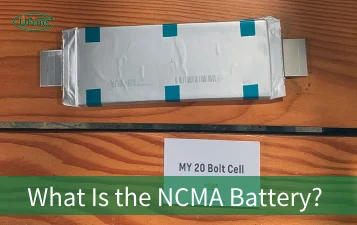
What is the NCMA battery? What is the difference between it and the NMC battery? Which one is better? This article will answer your questions.
What Is the Lithium Battery Short Circuit?
What is the lithium battery short circuit? To understand a lithium battery short circuit, we first need to understand how the battery works.
How to Distinguish Battery Cells, Battery Modules, And Battery Packs?
Discover how battery cells, modules, and packs work, their engineering roles, and practical guidance for safe and efficient design.
What is the Difference Between Silver Zinc Battery vs. Lithium-ion Rechargeable?
Compare silver zinc and lithium-ion rechargeable batteries: energy density, cycle life, safety, cost, and uses in drones, medical devices, EVs, and electronics.
What are Watts and Watt Hours in Battery?
Understand watt vs watt-hour in batteries: key differences, how to calculate capacity, and why they matter. Includes free comparison table.
